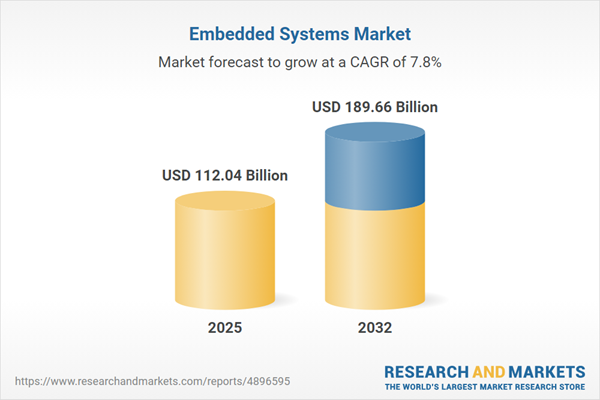Speak directly to the analyst to clarify any post sales queries you may have.
The embedded systems market is experiencing accelerated transformation, with embedded technologies driving intelligent innovation and operational efficiency across industries.
Market Snapshot: Embedded Systems Market Overview
The Embedded Systems Market grew from USD 104.33 billion in 2024 to USD 112.04 billion in 2025 and is projected to reach USD 189.66 billion by 2032, growing at a CAGR of 7.75%. This growth reflects rising integration of embedded platforms within industrial, automotive, healthcare, and telecommunications sectors, fueled by increased demand for real-time data processing, edge intelligence, and next-generation connectivity. Enhanced processing capabilities, adoption of advanced sensor technologies, and expanded software ecosystems are accelerating market momentum as organizations seek to optimize performance and reliability.
Scope & Segmentation
- Component: Hardware components, such as I/O interfaces, memory devices, power supply, and a range of processors (digital signal processors, general purpose processors, microcontrollers, microprocessors).
- Software: Firmware, middleware, and operating systems form the software stack, enabling resilience, integration, and flexibility in varied applications.
- Embedded Systems Type: Mobile embedded, networked embedded, real-time (hard and soft), and stand-alone embedded systems, enabling both connectivity-focused and latency-sensitive solutions.
- System Size: Complex, medium scale, and small scale systems tailored to the needs of aerospace, industrial, medical, and consumer electronics.
- Application: Addressing requirements in aerospace and defense, automotive (driver assistance, infotainment, telematics), consumer electronics, energy and utilities, healthcare, industrial automation (factory, process control, robotics), and IT & telecommunications.
- Region: Americas (United States, Canada, Mexico, Brazil, Argentina, Chile, Colombia, Peru), Europe, Middle East & Africa (UK, Germany, France, Russia, Italy, Spain, Netherlands, Sweden, Poland, Switzerland, UAE, Saudi Arabia, Qatar, Turkey, Israel, South Africa, Nigeria, Egypt, Kenya), Asia-Pacific (China, India, Japan, Australia, South Korea, Indonesia, Thailand, Malaysia, Singapore, Taiwan).
- Key Companies: Advantech Co., Ltd.; Analog Devices, Inc.; Arm Limited; Broadcom Inc.; Cisco Systems, Inc.; Honeywell International Inc.; Infineon Technologies AG; Intel Corporation; Kontron AG; Microchip Technology Incorporated; Mitsubishi Electric Corporation; NVIDIA Corporation; NXP Semiconductors N.V.; Panasonic Holdings Corporation; Qualcomm Incorporated; Real-Time Systems GmbH; Renesas Electronics Corporation; Samsung Electronics Co., Ltd.; Siemens Aktiengesellschaft; STMicroelectronics N.V.; Texas Instruments Incorporated; Wind River Systems, Inc.; WIPRO LIMITED.
Key Takeaways
- Technological convergence—spanning sensor integration, connectivity standards, and edge computing—is reshaping design philosophy and embedded product innovation.
- Adoption of 5G and advances in artificial intelligence are enabling new service models in smart cities, automation, and connected vehicles.
- Sustainability goals are now significantly influencing low-power processing design and sourcing of novel semiconductor materials.
- Strategic partnerships and industry collaborations are key for co-development, interoperability, and portfolio expansion in response to evolving demands.
- Application-specific segmentation requires solutions tailored to industry-specific operational, reliability, and regulatory needs.
Tariff Impact on Supply and Strategy
New tariffs introduced in the United States from 2025 are reshaping global supply chain and sourcing strategies in the embedded systems market. OEMs and suppliers are diversifying procurement across alternative Asian and Latin American regions to reduce exposure to duties on semiconductors and associated hardware. This regulatory landscape also incentivizes local manufacturing investments, automation, and the adoption of joint venture models. As hardware costs adjust, emphasis on software optimization and turnkey integration services is expected to increase.
Methodology & Data Sources
This report utilizes a hybrid methodology, combining primary interviews with industry stakeholders and extensive secondary analysis from market reports, regulatory filings, and technical journals. Data triangulation and expert reviews ensure reliability and capture cross-sector perspectives for actionable market insight.
Why This Report Matters
- Offers a strategic roadmap to navigate embedded system technology shifts, supply vulnerabilities, and regulatory complexities.
- Empowers senior leaders and investors with segmentation analysis, regional trends, and actionable recommendations for innovation, risk mitigation, and sustainable growth.
Conclusion
The Embedded Systems Market will continue to evolve as organizations embrace edge intelligence, diversified supply networks, and adaptive design strategies. This report equips decision-makers to act on new opportunities and address future challenges with clarity and confidence.
Additional Product Information:
- Purchase of this report includes 1 year online access with quarterly updates.
- This report can be updated on request. Please contact our Customer Experience team using the Ask a Question widget on our website.
Table of Contents
3. Executive Summary
4. Market Overview
7. Cumulative Impact of Artificial Intelligence 2025
Companies Mentioned
The companies profiled in this Embedded Systems market report include:- Advantech Co., Ltd.
- Analog Devices, Inc.
- Arm Limited
- Broadcom Inc.
- Cisco Systems, Inc
- Honeywell International Inc.
- Infineon Technologies AG
- Intel Corporation
- Kontron AG
- Microchip Technology Incorporated
- Mitsubishi Electric Corporation
- NVIDIA Corporation
- NXP Semiconductors N.V.
- Panasonic Holdings Corporation
- Qualcomm Incorporated
- Real-Time Systems GmbH
- Renesas Electronics Corporation
- Samsung Electronics Co., Ltd.
- Siemens Aktiengesellschaft
- STMicroelectronics N.V.
- Texas Instruments Incorporated
- Wind River Systems, Inc.
- WIPRO LIMITED
Table Information
| Report Attribute | Details |
|---|---|
| No. of Pages | 182 |
| Published | November 2025 |
| Forecast Period | 2025 - 2032 |
| Estimated Market Value ( USD | $ 112.04 Billion |
| Forecasted Market Value ( USD | $ 189.66 Billion |
| Compound Annual Growth Rate | 7.7% |
| Regions Covered | Global |
| No. of Companies Mentioned | 24 |









